Portfolios and Resumes
You should keep your portfolio and resume up to date at all times. While you’re entrenched in any given production, you may believe that you’ll never forget the exact date, theatre or director you’re working with, but you will quickly find that shows run together in your mind. You must stay on top of them, updating constantly. Just as every show is an opportunity to experiment with your design skills, you should keep a file of those shows for your own records and for use in displaying your abilities to others.
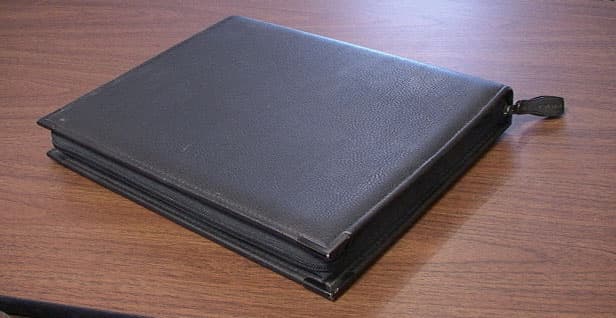
With the ease of the computer, keeping separate resumes for various purposes has become much easier. The first thing you need to do is keep track of every performance you have worked on.
Designers tend to present their materials in reverse chronological order. This means you want to keep a running list, from the most current project at the top of the list, with the first production you worked on at the bottom.When you’re just beginning your design career, every listing is valuable. Once you have built up an extensive resume, you can begin refining it for more specific positions and prospective employers. The need to add to, correct, clarify and refine a resume is a continuing
process. You may, over time, develop several different versions of your resume.
For each production, keep track of the following:
- Production name
- Director
- Date of opening (month/year is usually sufficient)
- Producing organization
- Theatre space / venue
- Your position
Directors and producing organizations are very important, because often prospective employers may have worked with some of the people you have – which may lead to valuable, personal recommendations. Prospective employers may have worked on the same production with a different group of people which could be a discussion point during an interview.
If you keep one list constantly up to date, you can then pull together separate resumes highlighting different production experiences that are appropriate, depending on the position for which you are applying. Although you may be applying as a Master Electrician for a theatre that mainly houses dance productions, you may want to highlight times you have worked on other dance shows in various capacities. Focus on your special skills such as followspot positions, ability to read sheet music, knowledge of audio equipment. Such additional skills may sway prospective employers if other applicants for the position do not have them.
Designers tend to have resumes broken down into four general categories:
- Your name and contact information
- Training or degree base
- Production experience
- References
| Remember that in addition to your resume, you should also submit a “Cover Letter” in which you can introduce yourself personally, discussing how your abilities and skills are appropriate to the position you are applying for. Both the resume and cover letter should be proofread and professionally presented. |
Keeping records: Reviews, photographs and paperwork.
Reviews: Always try to remember that if the lighting design is not mentioned in a review, that means you did a good job of matching the work of the others on the team. It’s also true that when costumes and mood are complimented in a review, the lighting is a large part of making those areas look the way they should.
I also usually keep an extra “file copy” of the entire newspaper so that I can re-do the presentation at a later time.
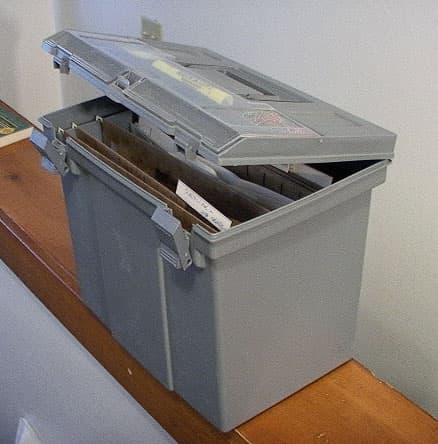
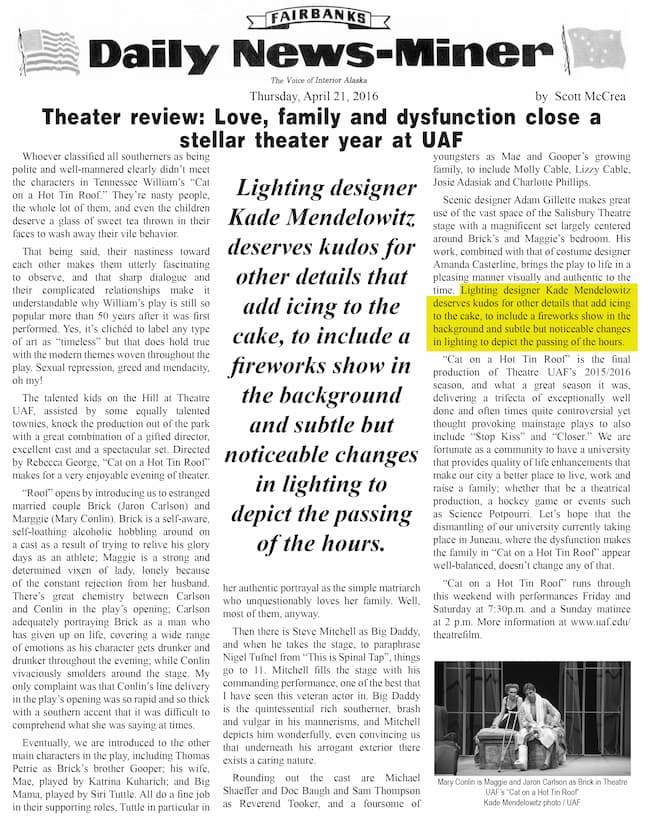
Review with pull-quote, reassembled to be in a standard print size / easy to print PDF.
Typically, if I used a pull-quote I wouldn't highlight it; choose one or the other for your usage.
Typically, if I used a pull-quote I wouldn't highlight it; choose one or the other for your usage.
Keep photographs of each production you work on, if possible highlighting the aspect you worked on (a prop you built, or a drop you painted).
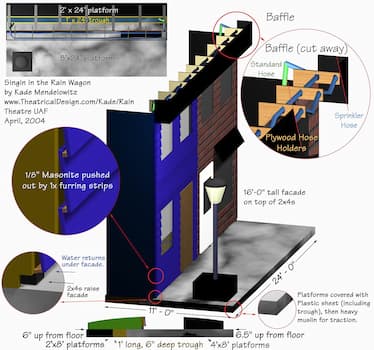 Drawing sample |
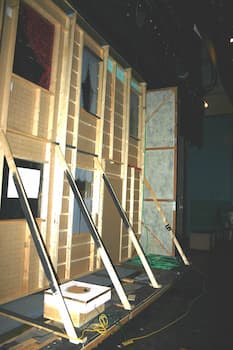 Behind the scenes |
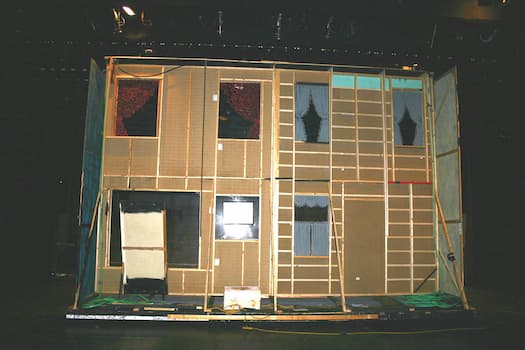 Behind the scenes |
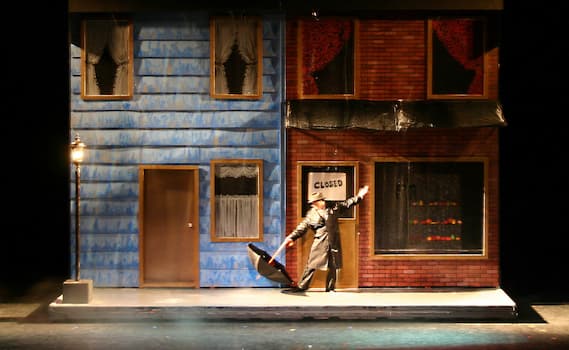 Production photo |
Photographing production lighting is difficult and takes a great deal of practice. There are a few areas to consider when you attempt to match the demands of capturing accurate lighting effects. Areas of concern include:
Other designers often get photos that highlight their work better than yours. Costumers typically get photos using a flash during a rehearsal – so they don’t mind that the actors are still moving. Set designers can get stage shots after a rehearsal when the stage is bare – with minimal impact on other people’s time.
- Cast time
- Color temperature of the film / white balance of the camera
- Setups
| To get the best image of indoor lighting possible, it is often necessary to ask the actors to “freeze” in action during a particular scene. Getting a great photograph requires the cooperation of the entire cast and crew. For the most accurate picture possible, I request a photocall of the actors in costume after an afternoon matinee. Prepare a list ahead of time including the moments you want, the scenes, which characters are on stage, necessary props, and, of course, the light cue. |
The more organized you are, the more willing the cast will be to help you get the shots you want, because you are not wasting their time. Since photocall usually follows a performance, it’s usually most efficient to go in reverse order since the characters are in their final act clothing already. Be sure the photocall is posted in advance warning the actors and crew of the additional time needed that day, and post the list you’ve created if possible so the actors can get into the appropriate costumes, etc.
You may have to slightly adjust your light levels to get a good photograph; if so, do your best to keep the feeling of the cue intact.
For example, to photograph actors in front of projections, you may have to dim the light on the actors to somewhat balance their intensity with the projector. You’ll have to use your judgment or a light meter.
I usually rely on the light meter of my camera. While professional photographers take various meter readings from different points on the stage, you almost certainly don’t have the time to run up with a meter between each shot.
Bracketing: a cheap insurance policy.
Bracketing is a term used to describe taking a photo at the recommended f-stop and shutter speed, then also taking the same photo with the f-stop +1 and –1 to let a little more, and a little less, light through the lens. Often you will prefer one of the three resulting photographs.
F-stop refers to how large your lens opens to let light through. Shutter speed refers to how long the lens stays open.
If your aperture (f-stop) doesn’t open any further; slowing down the shutter serves the same effect if the actors can hold their positions.
| Many modern digital cameras can be set to “auto-bracket”; so the camera will “auto-fire” a series of 3 photos when you push the shutter release button. See if your camera can use this setting! |
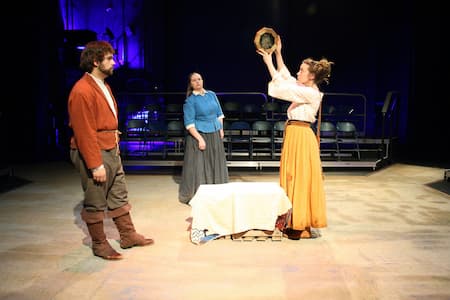 Suggested exposure. .8 seconds @ f/3.5 |
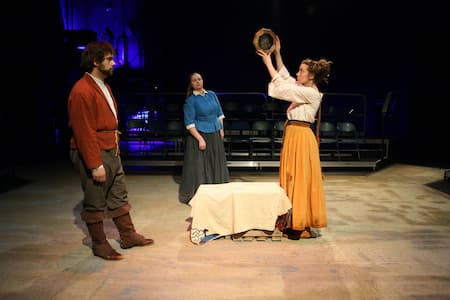 Faster exposure. .4 seconds @ f/3.5 |
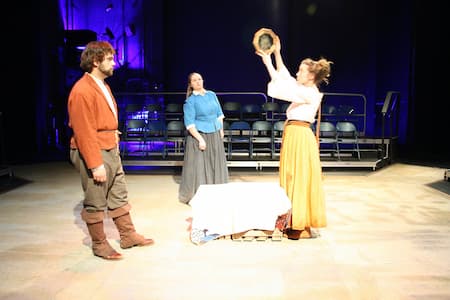 Slower exposure. 1.6 seconds @ f/3.5 |
In this set: the center would be my personal preference. In the "suggested exposure" the whites are blown out, and there's too little floor detail. Production photos from "Vinegar Tom". Lighting design by Adam Gillette. | ||
Focus, lock and move.
Often there are multiple characters, set pieces, and areas to focus on. You must choose the primary target to focus on for each shot. The area that is in focus is called the depth of field, which is limited, especially in low-light situations. Choose what you want to focus on, lock that in, then compose your shot by moving the camera.
Most cameras today have auto-focus. Usually, you can aim at your main character, push the shutter button half-way down to focus, then while you continue to hold the release half-way you may re-compose your photo. To shoot, just finish pressing the shutter release button. It may take you a while to master this technique, but it’s well worth the effort.
Before each shot, try to take a moment and ask yourself three questions:
- What’s going on with my subjects?
- What’s going on with the foreground?
- What’s going on with the background?
I recommend keeping a physical portfolio handy in addition to a web prescence. For a physical portfolio I usually limit each production to 3 photographs in my portfolio, each at least 5x7” in size, although 8x10 is better. With the larger format, people will have to rotate your book for horizontal images, so you may want to mix and match your sizes depending on the photo orientation. I usually try to include one typical lighting cue, one “special” cue from the show, and one from a moment that I may have a story to talk about.
I put my best photographs first, even though that show may not be my favorite show. At this point the question is: which show looks the best now? Not which show was the best?
Sometimes the worst productions look the best when the photographs are done. Be mindful of that when working on challenging productions – often the results are outstanding.
Paperwork. I usually only carry one full set of draftings for a particularly interesting production I’ve worked on and the supporting paperwork (instrument schedule, cue plot, etc.). Most interviewers will not look at a drafting for long because the plans are so far out of context during an interview. Bring one set so they can see you know how to communicate to a crew and they can always request that you send them other copies. Always bring blue lines, never your original draftings. I fold them and place them in my portfolio.
Although folded draftings are less attractive than rolled, carrying a tube with you to an interview can be awkward, especially if you’ll be using any type of public transportation including buses, trains, planes or even taxis. Your originals are precious; treat them as such and leave them at home. Accidents occur at the most inconvenience times.
Presentation. You are a theatrical designer. If you haven’t realized by now that presentation is everything, you’ve missed something. Presentation is what we do. A prospective employer will be reluctant to hire someone who does not present himself/herself well.
-
Here are some final thoughts regarding your personal presentation:
- Portfolios
- Yourself
- Preparation
Portfolios come in all shapes and sizes. Many are handmade. While costumers and the like can be very creative with their portfolios, most directors are looking for lighting designers who are organized. I prefer using zippered 8.5x11 folios. They can be found at some office supply stores, and can be weather resistant.
- You can find many specialty pages including:
- Pockets for draftings
- Page protectors for photographs
- Pages for CDs or other media
Show pride in yourself. Be on time for your interview/presentation; being early gives you time to relax before your appointment. Dress for the job you want, not for the job you have. You may be applying for a job that allows t-shirts, but you shouldn’t wear one to the interview. Take a shower, comb your hair, brush your teeth, and call your mother. Well, you may not have to call your mother, but call to verify your appointment and check that you know how to get to your destination.
Preparation. Be ready to talk about yourself and your work. You may be meeting with an individual (director or producer) or a team. Have projects in your portfolio that excite you so you can talk about them with enthusiasm. Do some research about the people or organization you are interviewing with so you know what they are looking for in a prospective employee. This is also a good opportunity for you to ask questions about their operating procedures.
| Remember; the organization interviewing you is also being looked at; you don’t have to accept the job unless you want it, and asking questions about their organization shows them you know what you’re getting into if you are hired. |
There are many free and low-cost alternatives to starting a website. Popular solutions include Wordpress.com.
While there’s nothing wrong with Instagram, YouTube, Facebook, TikTok and other Social Media platforms for sharing your work; establish a more cohesively designed website experience (WordPress, for example, has many templates to choose from) that you have more control over. Also: be sure to keep your personal life and posts separate from your professional site.
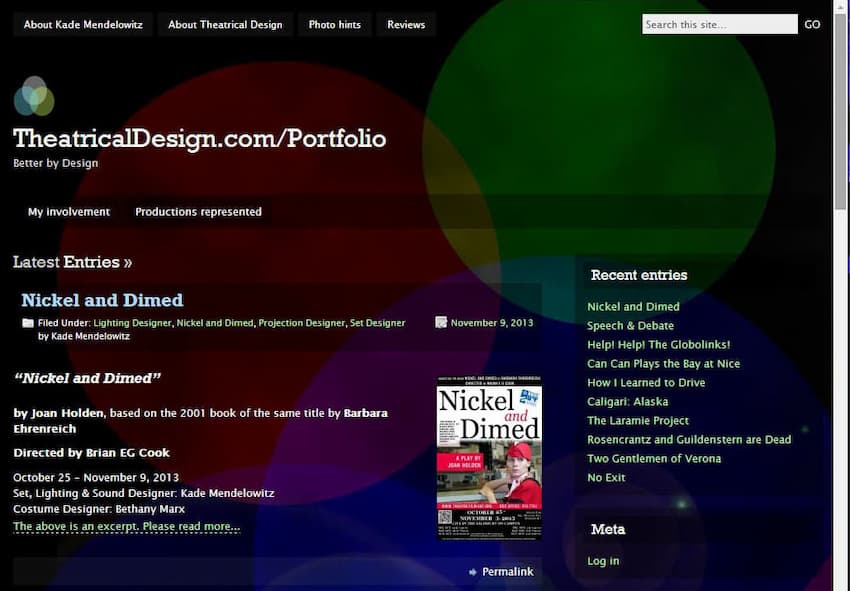
These are both free themes available via WordPress that allow you to quickly change the layout and feel of your site. Wix.com and others have similar offerings.
|
| Not everyone begins designing right away. You may have to work as an electrician or Assistant Lighting Designer on a few productions first, and there’s nothing wrong with that. |

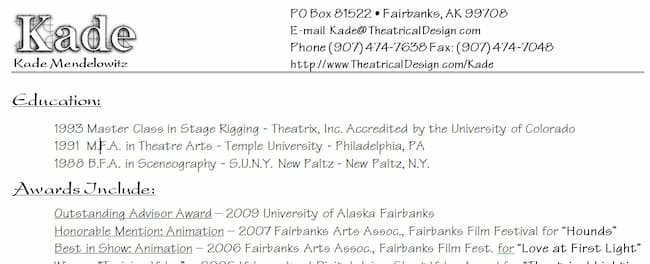


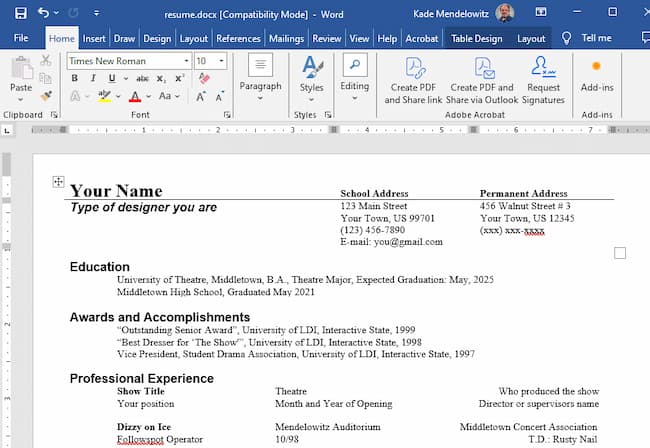

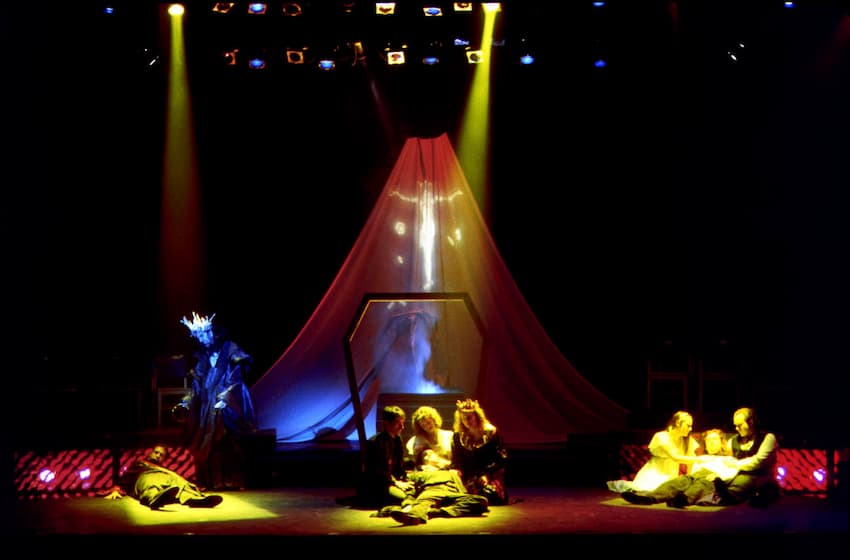
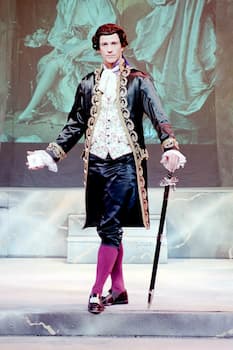


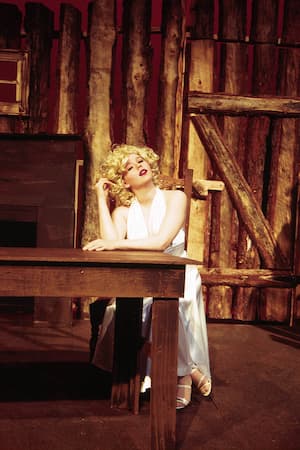
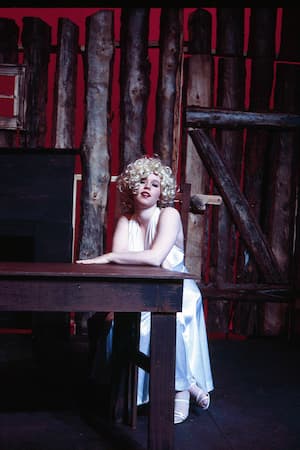

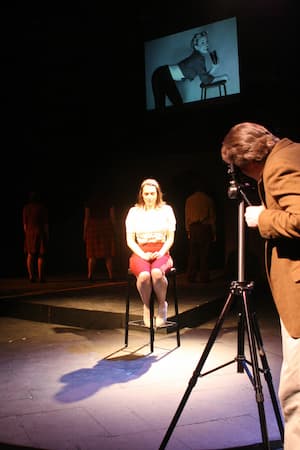
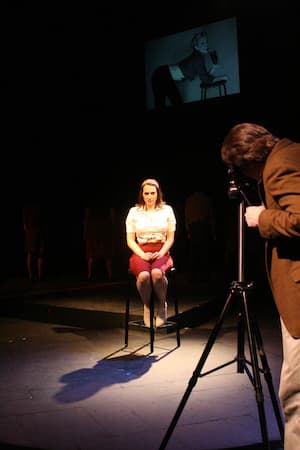
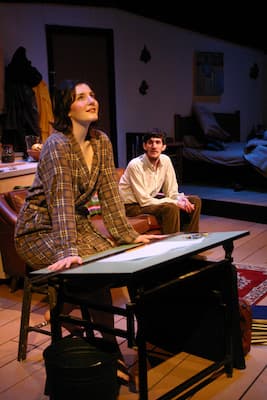
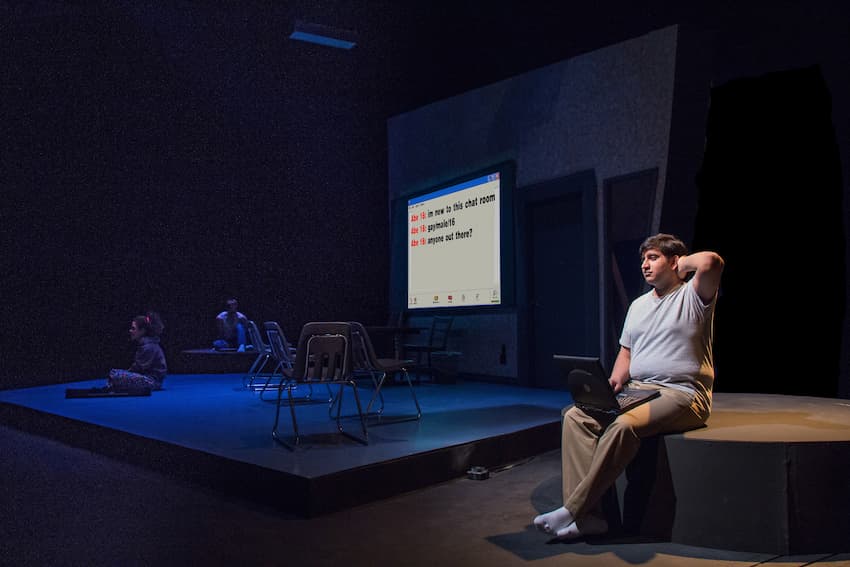
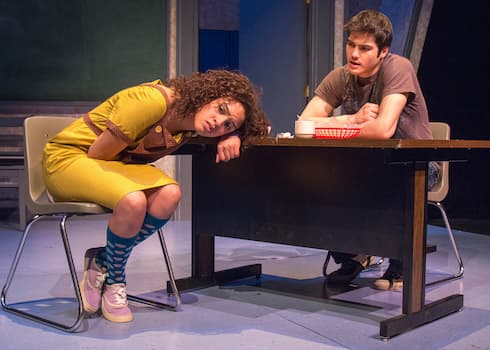
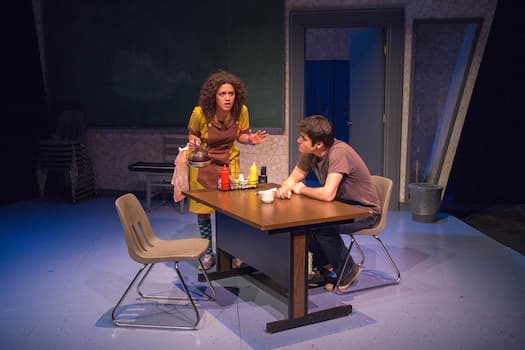




 © Multimakers Multimedia
© Multimakers Multimedia